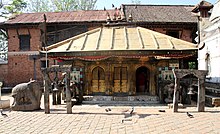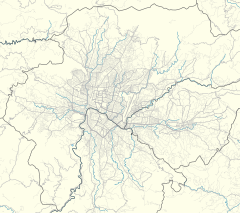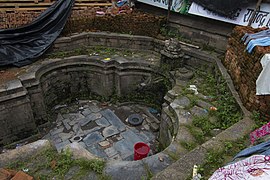Changu Narayan Temple
This article has multiple issues. Please help improve it or discuss these issues on the talk page. (Learn how and when to remove these template messages)
|
| Changu Narayan Temple | |
|---|---|
 Changu Narayan temple | |
| Religion | |
| Affiliation | Hinduism |
| District | Bhaktapur |
| Province | Bagmati |
| Deity | Vishnu |
| Festivals | Teej, Prabodhini Ekadashi, Naag Panchami |
| Location | |
| Location | Changunarayan |
| Country | Nepal |
| Geographic coordinates | 27°42′58.6″N 85°25′40.4″E / 27.716278°N 85.427889°E |
| Architecture | |
| Type | Pagoda |
| Creator | Haridatta Barma |
| Criteria | Cultural: (iii)(iv)(vi) |
| Designated | 1979 (3rd session) |
| Part of | Kathmandu Valley |
| Reference no. | 121bis-007 |
Changu Narayan is an ancient Hindu temple, located on a high hilltop that is also known as Changu or Dolagiri in Changunarayan Municipality of Bhaktapur District, Nepal. The hill is about 7 miles (12 km) east of Kathmandu and a few miles north of Bhaktapur. The Manohara River flows beside the hill. The temple, considered to be one of the oldest in Nepal, is dedicated to Vishnu[1] and is revered by Hindus.
The temple was surrounded by champak tree forest and a small village known as Changu. A Kashmiri king is said to have given his daughter, Champak, in marriage to the prince of Bhaktapur. The temple is considered to be named after her.
Home » Heritage » 5 temples of Kathmandu that are more than 1,000 years old
5 temples of Kathmandu that are more than 1,000 years old Onlinekhabar Onlinekhabar Onlinekhabar Saturday, August 15, 2020
0Comments
1.1k Shares facebook sharing buttontwitter sharing buttonmessenger sharing button
File: Pashupati area in Kathmandu Nepal, with a majority of Hindu population, has uncountable temples, shrines, stupas, and various other icons, idols, statutes, and pictures that people worship. They are all built for different gods and goddesses, or their different forms or incarnations. Many temples were created by rulers of different times to show their devotion to the gods and goddesses they worshipped the most.
Most of the temples in Kathmandu were built or given makeovers after the onset of the 15th century. But, there are a few that have been found or known to be older than 1,000 years old. These are the landmarks that hold centuries of history and information, making them a valuable part of national heritage.
So, below are a few of the oldest temples in Nepal with more than 1,000 years of history. The list is prepared in consultation with noted historian Mahesh Raj Panta.
1. Changunarayan Changunarayan Temple Photo: fabulousfabs/ flickr Changunarayan is one of the oldest temples built in Nepal’s history. It was built during the reign of King Manadeva from the Lichhavi dynasty in 464 AD, according to an inscription found in the temple premises. It is dedicated to Lord Vishnu (also known as Purusha/Narayan). This temple is located in Bhaktapur. It is a two-tiered pagoda-style temple with four doors, guarded by stone lions.
On the western side of the temple, a giant statue of Garuda is placed, and King Bhupatindra Malla and his queen in the front. The main attraction of the temple is the Narasingha (half lion and half man) statue. This temple is named after King Kashmiri’s daughter, Champak, who was married to the prince of Bhaktapur.
2. Swayambhu Chaitya
File: Swayambhu Stupa Swayambhu Chaitya, also known as the Monkey Temple, is one of the most sacred temples for both Hindu and Buddhist populations in Nepal. It is located on the top of a hill in the Kathmandu valley, west of the city. This stupa is also known as the crowning glories of architecture in Nepal. Swayambhu was built by King Manadeva in around 460 AD and is known as one of the oldest religious sites in Nepal.
A mythological story suggests that Swayambhu (self-emerged) born out of a lotus flower. This flower bloomed, and a light (jyotirup) was formed in the middle of a lake, which later transformed into the Kathmandu valley. The stupa consists of a white dome-like structure at the base and a tower at the top. Three eyes are painted on each of the four sides above the dome, representing the Buddha. Around the stupa, several idols of Buddha are
Physical Aspects[edit]
Changu Narayan Temple is placed at the top of a hill surrounded by a forest of Champak trees. People from the Brahman, Chhetri, Tamang, Newar and other communities live in and around Changu Narayan area. With the development of tourism in this place, we can find many medium and small sized hotels, restaurants, souvenir shops, etc. An ancient stone tap is located on the way to Changunaran which is believed to have existed since the time of Lichhavi.
The Temple art and architecture[edit]
Changu Narayan is considered to be the oldest temple of Nepal. It remains a milestone in Nepali temple architecture with rich embossed works. The two-storey roofed temple stands on a high plinth of stone. According to Professor Madhan Rimal, Department of Sociology and Anthropology, Tribhuvan university the temple is neither in Shikhara style nor the pagoda style. It has an architectural style which he would like to describe as a traditional Nepali temple. Many similar features are found at Gokarna Mahadev. The temple is surrounded by sculptures and arts related to Lord Vishnu. Also, we can find the temples of Lord Shiva, Ashta Matrika, Chhinnamasta, Kileshwor and Krishna inside the courtyard of the main temple. There are four entrances to the temple and these gates are guarded by life-size pairs of animals such as lions, sarabhas, griffins and elephants on each side of the entrances. The ten incarnations of Lord Vishnu and the other idols are carved in the struts, which support the roof.
The entrance door is gilded with carvings of Naga (snakes). On the main entrance gate (i.e. western entrance gate), we can find the Chakra, Sankha, Kamal, and Khadga all at the top of a stone pillar. These stone pillars have an inscription in Sanskrit. This inscription is considered to be the oldest inscription of Nepal and the stone inscription pillar was erected by Licchavi (kingdom) King Manadeva in 464 AD.
The following monument is located while visiting the temple from the right side after entering from the main entrance (Eastern gate) to the courtyard


- Historical pillar erected by Mandeva in 464 AD
- Garuda: flying vehicle of Lord Vishnu which has got a human face and is a devotee of Vishnu.
- Chanda Narayan (Garuda Narayan):- a 7th-century stone sculpture of Vishnu riding on Garuda. This sculpture has been depicted in the 10 rupee paper note issued by Nepal Rastra Bank
- Sridhar Vishnu:- 9th century stone sculpture of Vishnu, Laxmi, and Garuda which stands on the pedestals of various motifs.
- Vaikuntha VishnuA: 16th-century sculpture of Vishnu seated on the Lalitasan position on the six armed Garuda and Laxmi seated on the lap of Vishnu
- Chhinnamasta:- Temple dedicated to Chhinnamasta Devi, who beheaded herself, offered her own blood to feed the hungry Dakini and Varnini.
- Vishworup:- 7th century stone sculpture- beautifully carved that depicts the scene from the Bhagwat Gita, in which Lord Krishna manifests his universal form to his devotee Arjun.
- Vishnu Vikrant: 7th-century sculpture of Trivikram Vishnu that depicts the scene of popular Hindu myth of Lord Vishnu and his beloved Bali Raja.
- Narasimha: a 7th-century sculpture of Narasimha, an incarnation of Lord Vishnu, killing the demon King Hiranyakasyapa to save his beloved devotee Prahalad.
- Kileshwor: small two-storied temples of Lord Shiva, who is believed to have appeared in this place for the protection of the hill.
The main image in the sanctum is worshiped by Hindus as a Garuda Narayan, and by Buddhists as a Hariharihari Vahan Lokeshwara. Only the priest is allowed to see the image.
Information Centre[edit]
There is an information centre at the entrance to Changu Village. They issue tickets to the tourists. The information centre has a public toilet for tourists. Also, there are drinking water facilities for the tourists. But the drinking water facilities have not been managed properly. Only direct tap water is available there. According to Binaya Raj Shrestha, owner of Chagu Museum and the member of temple management committee, on an average 150 foreigners visit Changu.
Changu Museum[edit]
A private museum is also located on the Changu Narayan on the way to the temple. According to the owner of the museum, it is the first private museum of Nepal and it has the collection of ancient coins, tools, arts, and architecture. There is an excellent collection of ancient, historical, artistic, religious, archaeological, cultural and other rare objects. The museum has a good collection of ancient tools used by the Newar family during the medieval period. It was established on the occasion of the millennium year 2000 AD with the permission of Changu Narayan VDC. The entrance fee for Nepalese is NRs. 100 and NRs. 300 is charged for a foreigner. On an average 30 to 50 visitors visit this museum in a day. Mostly foreigners and Nepali students visit this museum.
Ethnographic Museum[edit]
There is an ethnographic museum nearby the temple which incorporates both objects and photographs collected by Judith Conant Chase. Amatya Sattal was a rest house established by an Amatya family of Bhaktapur shifted to Patan for preparation of rituals and feasts for rights of passage and annual occasions. Living Traditions Museum was established here in 2011 under an agreement with the Department of Archaeology and Guthi Sansthan and openase lighting in the uppermost level. The museum is currently under reconstruction since the 2015 earthquake the occasion of family ritual etc.l conduct special puja at the templ. One of the festival of Changu is Nag Panchami and Hari Bodhani
Management Approaches[edit]
Changu Narayan Temple is on the list of world heritage sites. The valuable stone sculpture and ancient inscriptions have archeological, historical and cultural significance. Changu Narayan VDC has formed a committee called Changu Narayan Temple Management Committee which is the responsible body to work for protection, preservation, and management. Likewise the Department of Archeology and Palace Management Office, Bhaktapur has also provided assistance on the conservation and preservation of the temple. Many local youth clubs are involved in managing festivals, organizing awareness programs in and around the temple area.
Threats/ Challenges[edit]
The Manohara stream has long seen rampant mining of sand and stones. The local administration has failed to control the mining activities. Because of the mining activities, the temple area has become prone to landslides. Due to overgrazing in the nearby forest, the chances of soil erosion and landslides are very high.
Gallery[edit]
-
Manadevas Pillar
After 2015 earthquake photo gallery[edit]
-
temple and the priest
-
Temple's Museum
-
West side of temple
-
Stone spouts at Chagunarayan
See also[edit]
References[edit]
https://www.insidehimalayas.com/the-changu-narayan-temple-legends...
- von Schroeder, Ulrich. 2019. Nepalese Stone Sculptures. Volume One: Hindu; Volume Two: Buddhist. (Visual Dharma Publications). ISBN 978-3-033-06381-5. Contains SD card with 15,000 digital photographs of Nepalese sculptures and other subjects as public domain.





















